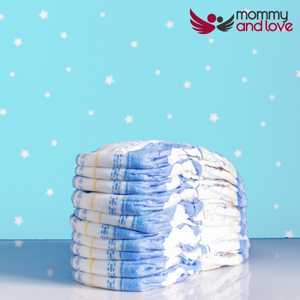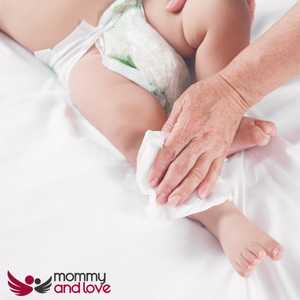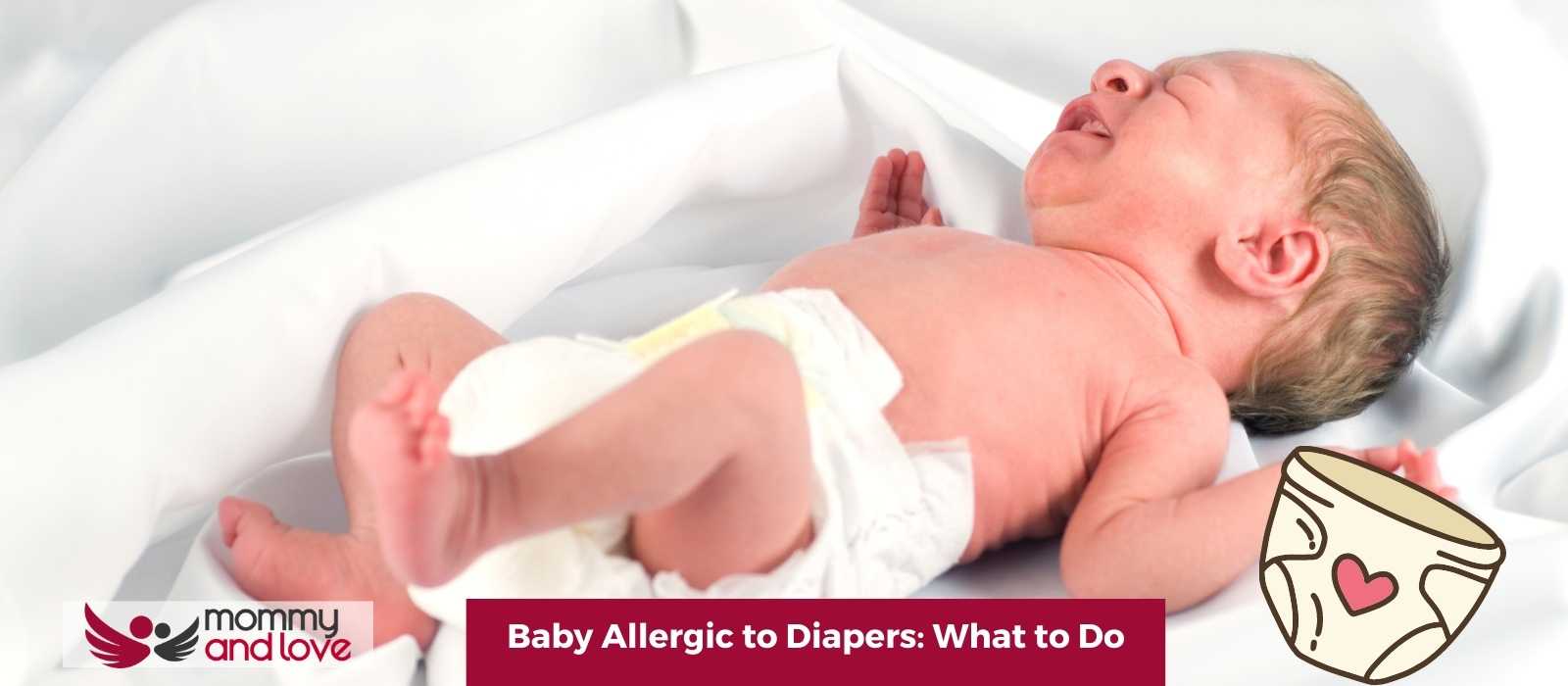If you have a baby that is allergic to diapers, it can be a huge challenge. You may feel like you are at your wits’ end and don’t know what to do. Don’t worry, we are here to help! In this blog post, we will discuss some of the best ways to deal with a baby who is allergic to diapers. We will also provide some tips on how to make life easier for both you and your child.
Is It Possible for Babies to Have an Allergic Reaction to Diapers?
Yes, it is possible for babies to have an allergic reaction to diapers. The most common type of allergy is contact dermatitis, which is a reaction that occurs when your baby’s skin comes into contact with something that irritates it.
Diapers can contain many different materials that may cause an allergic reaction, including latex, dyes, fragrances, and adhesives. If your baby is allergic to one or more of these materials, it can be very uncomfortable.
Symptoms of a diaper allergy may include redness, itching, swelling, and blistering. If you think your baby may be allergic to diapers, it is important to find a solution that works for both you and your child.
There are a few things that you can do if your baby is allergic to diapers.
- Try using hypoallergenic or all-natural diapers. These diapers are made without the use of harsh chemicals or fragrances, and they may be less likely to cause an allergic reaction.
- Use a diaper rash treatment cream or ointment that contains zinc oxide during each diaper change. Diaper cream or petroleum jelly can help to soothe your baby’s delicate skin and protect it from further irritation.
- Give your baby some air time. Whenever possible, try to let your baby go without a diaper for a little while. This will give their skin a chance to breathe and may help to reduce irritation.
- Modify your diapering routine and change diapers as often as you can. Wet diapers can cause irritation of the skin especially if your baby’s poop and urine stays too long and come in contact with your baby’s bum.
- Switch to washable diapers. Most of these reusable diapers are made from natural materials that are considered hypoallergenic to prevent diaper rash in the diaper area from occurring again. Wash cloth diapers with warm water and mild detergent and don’t use fabric softeners.
- Talk to your doctor. If you are struggling to manage your baby’s diaper allergy, be sure to talk to your doctor. They may be able to prescribe a medicated cream or ointment that can help to relieve symptoms of the skin infection based on the type of rash your baby is having.
Dealing with a baby who is allergic to diapers can be difficult, but it is not impossible. By using some of the tips and tricks above, you can make life a little easier for both you and your child.
What Causes the Diaper Allergy?

One or more materials of the diaper can cause an allergy in a baby.
So it’s important to know which of these materials are causing the reaction so that you can avoid them in the future.
Chlorine
There is no definitive answer to this question as each baby’s skin reacts differently to various chemicals and substances. However, some parents report that their babies develop diaper rashes in the skin folds after exposure to chlorine found in diapers. If your baby has sensitive skin, it may be worth avoiding diapers with chlorine. Likewise, avoid swimming in a pool or using wipes that contain chlorine.
Dyes
According to a recent study published, certain diaper rashes may be caused by the dyes found on diapers themselves. While most diaper rash is due to irritation from wetness or friction, the dyes used to make diapers more visually appealing could also be a contributing factor.
Scents and Fragrances
There are a few ways that diaper scents and fragrances can cause a baby’s rash. The first way is by irritating the skin. Many fragrances and chemicals used to make diapers smell nice can actually irritate a baby’s sensitive skin, especially if they have delicate skin. This can lead to redness, itchiness and irritation of the skin in the diaper area.
Another way that diaper scents and fragrances can cause diaper rash is by masking the smell of urine and feces. When diapers are not changed frequently enough, the urine and feces build up on the skin folds and can lead to irritation and rash. However, if a diaper smells nice, it may be less likely to be changed as often, leading to a buildup of urine and feces and eventually, diaper rash.
If you are concerned about your baby getting diaper rash, try using fragrance-free or unscented diapers. You may also want to consider using soft cloth diapers, which can be washed frequently without the worry of irritating fragrances.
Sodium Polyacrylate (Diaper Polymer)
When sodium polyacrylate is mixed with water, it forms a gel-like substance. This gel can absorb up to 300 times its weight in water. When this gel comes into contact with the skin in the diaper area, it can cause irritation and lead to rashes.
Sodium polyacrylate is also a known skin irritant. When it comes into contact with the skin, it can cause redness, swelling, and pain. In some cases, it can also lead to chemical burns.
Other Considerations
Allergies to baby diapers can develop and have been known to happen on some babies. However, other problems with similar symptoms and reactions are sometimes misdiagnosed as a diaper allergies.
Diaper rash, skin irritation in the diaper area, candida infections, and food sensitivities are symptoms that may appear to be caused by a diaper allergy but are far more frequent (and most likely the source) of what is causing your baby’s allergic reactions.
In any event, knowing the type of rash and what’s causing it is critical for determining the best course of treatment.
Diaper Rash
It could be the usual diaper rash. Diaper dermatitis or diaper rash is a skin condition that can occur in babies and young children who wear diapers. It is characterized by red, irritated skin in the diaper area. Diaper dermatitis is not usually serious, but it can be very uncomfortable for your child.
There are several things that can cause diaper dermatitis, including wet or soiled diaper, chafing from the diaper, sensitivities to certain materials in the diaper or laundry detergents used to wash the diapers, and infections. Your child develops a rash if he has delicate skin, is taking certain medications (such as antibiotics for bacterial infections), or has a condition that affects the skin (such as eczema).
Baby Wipes

The answer is actually quite simple. Most store-bought baby wipes contain alcohol and other skin irritants that can irritate the skin.
When you use these wipes on your baby’s bottom, you are essentially rubbing alcohol and other harsh chemicals into their delicate skin.
Over time, this can lead to a serious case of diaper dermatitis. If you want to avoid this, it is best to use a natural, hypoallergenic baby wipe that does not contain any harsh chemicals.
There are many brands of natural baby wipes on the market today that are safe for your newborn’s skin. Do some research and find a brand that you trust. Your baby’s bottom will thank you for it!
Yeast Infection
Yeast diaper rash is caused by the overgrowth of a type of yeast called Candida. Yeast infections can happen when there’s too much moisture in the diaper area. The rash appears as red, raised patches and pus-filled sores that may be painful or itchy. If your baby has a candida infection diaper dermatitis, it’s important to treat it right away to prevent the infection from spreading.
Fortunately, there are many effective treatments available. In most cases, treating a yeast infection diaper dermatitis is simple and straightforward. However, severe or recurrent infections may require more aggressive treatment.
Seborrheic Dermatitis
Seborrheic dermatitis is a skin condition that can affect babies and adults. It usually appears as a rash on the face, scalp, chest, or back. They may also have scaly skin and a rash that is red, crusty and oily patches. It can also cause itchiness and flaking of the skin. In severe cases, this bacterial infection on the skin can lead to hair loss.
There is no cure for these skin conditions, but treatments are available to help relieve symptoms. These include over-the-counter antifungal creams, shampoos, and lotions. For severe cases, prescription medications may be necessary. With proper treatment, seborrheic dermatitis can be controlled and the symptoms can be minimized.
Eczema or Atopic Dermatitis
Eczema is a general term for several different types of skin inflammation (dermatitis). Atopic dermatitis is the most common form of eczema. It usually starts in childhood but can occur at any age. The exact cause of atopic dermatitis is unknown, but it is thought to be due to a combination of genetic and environmental factors. Atopic dermatitis is not contagious.
Symptoms of atopic dermatitis can vary depending on the age of the person affected. In infants, atopic dermatitis usually appears as a dry, scaly rash on the face, scalp, or trunk. In older children and adults, it typically appears as dry, scaly, or crusted patches on the scalp, face, neck, inside the elbows, behind the knees, and on the hands and feet.
There is no cure for eczema, but there are treatments that can help to control the symptoms. These include over-the-counter and prescription medications, as well as lifestyle changes. With proper treatment, most people with eczema can live relatively normal lives. However, the condition can be very difficult to manage in some cases.
Food Allergies
There are many causes of diaper dermatitis but one of the most common is allergies to solid foods. When a baby has allergic reactions to a certain food, its immune system overreacts and causes inflammation. This can lead to red skin that looks like a rash.
There are a few ways to treat diaper dermatitis caused by a food allergy. The most important thing is to identify the offending food and avoid it. You might also need to use a barrier cream or ointment to protect your child’s skin. If the rash is severe, medication may be prescribed. With some care and treatment, most babies with a food allergy can get rid of their diaper dermatitis.
There are many different foods that can cause allergies in babies, but there are a few that are more common than others. Some of the most common allergens include cow’s milk, eggs, peanuts, soy, wheat, and seafood. Allergies to these foods can often be severe, so it’s important to know what to look for and how to avoid them.
In some cases, simply avoiding the allergen altogether is the best way to keep your baby safe and healthy. However, in other cases, your child’s healthcare provider may recommend allergy shots or medication. No matter what, they will be able to help you create a plan that will work for your family.
Skin Care Products
There are a few ways that skincare products can cause an allergic reaction in babies. The first way is by causing skin irritation. When the skin is irritated, it can become red and inflamed, which can lead to skin allergies. Another way that skincare products can cause diaper dermatitis is by blocking the pores.
When the pores are blocked, it can cause the skin to become irritated and lead to diaper rash. Finally, skincare products can also cause contact dermatitis. This is when the skin comes into contact with an allergen or irritant in the product, which can cause a child’s rash.
Prickly Heat
Prickly heat can be very uncomfortable. The best way to prevent it is by keeping your baby cool and dry. If your baby does get prickly heat, you can treat it at home with some simple self-care measures.
Prickly heat usually goes away on its own within a few days. But if your baby’s rash is severe or seems to be getting worse, call your child’s healthcare provider.
To prevent prickly heat:
- Dress your baby in light, loose clothing.
- Avoid overheating. Keep the room temperature cool and use a fan if needed.
- Avoid using lotions or oils during warm weather. These can make the rash worse.
- Give your baby a bath in cool water. Avoid using soaps, which can dry out the skin.
- Keep your skin dry. After bathing, pat the skin dry with a soft towel. Then, let the area air dry for a few minutes before dressing your baby.
Conclusion
If you are one of the unlucky few who has a baby with allergies to diapers, you know how frustrating and worrisome it can be. Allergies to disposable diapers are rare, but they do happen. And if the skin is overly sensitive, even a small amount of contact with the diaper material can cause a reaction. It is also important to determine the cause of diaper allergy.
So what do you do if you have a baby with allergies to diapers? The good news is that there are plenty of alternatives available. You can switch to cloth diapers, which many people find to be just as convenient as disposable diapers. Or you can try out some of the new eco-friendly disposable diapers on the market.

This article was written by: Gian MIller – Full-Time Writer, Baby Whisperer & Dad of 3.
Gian spends a lot of his time writing. A self-proclaimed baby whisperer, Gian has been through it all with his own children and is passionate about sharing his hard-won wisdom with other parents. When he’s not writing or changing diapers, you can find him playing the guitar or watching baseball (or preferably both at the same time).




